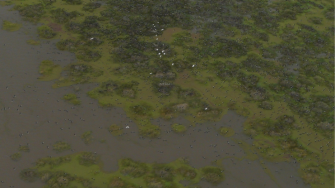
Date: Friday, October 21, 2016
Project: Eastern Australian Waterbird Survey
Observer: Terry Korn
Forecast rain and threats of 100km/hr. winds worried us as we departed south from Broken Hill for Renmark on the banks of the mighty Murray River. It was from here we were to begin our count in Band 3, heading east to Griffith to complete the days counting.
Lakes are a common feature around the Riverland town of Renmark. Photo Terry Korn
Our fears were to no avail as winds were tolerable, there was only a slight sprinkle and the cloud ceiling was 2000ft during the hour long trip to our start point in the South Australian Riverland.
The Murray is running at full capacity and more. All lagoons and lower floodplains are covered, creating wonderful habitat for waterbirds as we move into the nesting season for many species. But like yesterday, few waterbirds were evident. Pelicans, black swans and cormorants, all fish eaters, were the most common we saw on this trip. Black swans were also common but rarely concentrated. Ducks were rare and have obviously dispersed to the many active wetlands throughout eastern Australia. In two days of counting, I have seen fewer than 100 ducks, the biggest flock about 40 grey teal.
A shallow salt lake was the highlight of the morning for it yielded a pleasing concentration of red-necked avocets which are beautifully coloured birds, especially in flight from above with their gently pattering wing beat. This lake usually has mountain ducks but they seemed to have been replaced by concentrations of black swans this year.
Mildura is our refuelling and early lunch stop. This busy airport was crammed with passengers awaiting a jet flight to Sydney. Over the years we have seen this facility change from a very average one to an attractive, bustling, well organised one with large jets coming and going.
The Mildura to Griffith leg is a four hour flight due to the amount of time it takes to double count the complex wetland system of Yanga National Park and the Lowbidgee area near Balranald. Today it was more complex than usual because most of the country was flooded and the definition of specified wetlands was a challenge. Where do you start and stop when they are all connected by floodwater?
Yanga homestead and visitor centre for Yanga national park. Photo Terry Korn
Nonetheless the flooding created some beautiful scenery with tall red gums surrounding clear water filled with waving ribbon weed and topped by duck weed. Occasionally pelicans, egrets and swans adorned the wetland. A few small colonies of nesting egrets were sighted.
here are beautiful wetlands amongst the red gums of Yanga national park. Photo Terry Korn
In the Lowbidgee, flooding was extensive and this has triggered breeding by the colonial nesting Ibis. Only small colonies of White Ibis were seen but a number of colonies of Straw-necked Ibis have established, the biggest being about 5000 nests. This area is still receiving high inflows from the flooding Murrumbidgee River so it is likely the breeding will be successful.
A straw-necked Ibis colony in Lignum on the Lowbidgee wetlands. Photo Terry Korn
White and Straw-necked Ibis nesting in a red gum/lignum wetland. Photo Terry Korn
The Lowbidgee wetland is completely inundated. Photo Terry Korn
After the frenetic counting in the Yanga/Lowbidgee area we flew up the flooded Murrumbidgee and its inundated floodplain to Griffith, the bustling centre of the Riverina.
The Murrumbidgee River spills onto the floodplain. Photo Terry Korn
